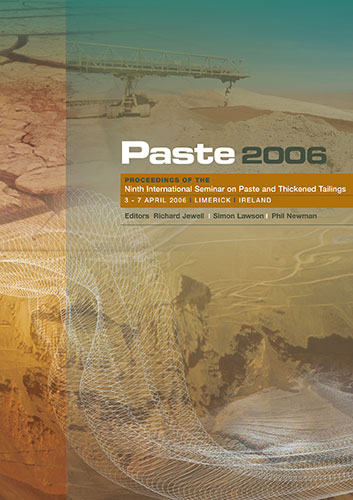Practical Aspects of Transporting Pastes with Rotodynamic Slurry Pumps

|
Authors: Bootle, M Paper is not available for download Contact Us |
DOI https://doi.org/10.36487/ACG_repo/663_36
Cite As:
Bootle, M 2006, 'Practical Aspects of Transporting Pastes with Rotodynamic Slurry Pumps', in R Jewell, S Lawson & P Newman (eds), Paste 2006: Proceedings of the Ninth International Seminar on Paste and Thickened Tailings, Australian Centre for Geomechanics, Perth, pp. 413-427, https://doi.org/10.36487/ACG_repo/663_36
Abstract:
Reduced safety concerns, reduced environmental impact, faster land reclamation, reduced water consumption and corresponding efficiency improvements are some of the possible benefits of mine disposal in the form of thickened tails or paste. Transportation of these higher density slurries presents special challenges for the system designer. The corresponding yield stress and higher viscosity associated with these higher density slurries often result in slurry pipeline operation in laminar flow at an elevated pipeline pressure drop. Much research is ongoing with respect to determination of pipeline friction, as well as solids settling in laminar flow. Previous work has looked at the economic benefits and disadvantages of rotodynamic (i.e., centrifugal) versus positive displacement pumps as the motive source for high density, high yield stress tailings. This work has shown the choice is not always clear cut. Initial capital outlay versus long term operating costs, pipeline length, slurry concentration, corresponding rheology, corresponding volume flow rate and corresponding pressure drop are integral factors in the decision making process. Rotodynamic pumps have been shown to be a viable choice for lower concentration, higher volume flow rate, shorter pipeline distance, lower pressure drop services. This paper will discuss the application limits of standard slurry pumps on high yield stress slurries, revisit an often misused method of predicting corresponding pump performance de-rating, present test data on a modified “flow inducer” equipped rotodynamic pump with improved high yield stress capability, and finally discuss rotodynamic pump suction requirements in an effort to explain the observed change in pump performance.
References:
Sellgren, A., Addie, G.R. and Whitlock, L. (2005) Technical-economical feasibility of using centrifugal pumps in high-density
thickened tailings slurry systems. Proceedings of the Eighth International Seminar on Paste and Thickened Tailings 20-22 April
2005, Santiago Chile. Australian Centre for Geomechanics, Perth, pp. 195-204.
Walker, C.I. and Goulas, A. (1984) Performance characteristics of centrifugal pumps when handling non-Newtonian homogeneous
slurries. Proc. Instn. Mech Engrs., Vol. 198A No I, pp. 41-49 (March, 1984).
Duckham, C.B. (1971) Design of centrifugal pump installations for viscous and non-Newtonian fluids. Chem. And Process Engng,
July 1971, 52 (7), pp. 66-68.
Vavra, M.H. (1960) Aero-Thermodynamics and Flow in Turbomachines. John Wiley and Sons, New York.
Roudnev, A.S. (2004) Slurry pump performance considerations. 16th International Conference on Hydrotransport, 26-28 April, 2004,
Santiago, Chile. BHR Group Limited, Cranfield, pp. 137-150.
Mogilevsky, Y.N. and Smoilovskaya, L.A. (1972) Suction performance of centrifugal pump when handling magnetite slurry. Hydro-
Mechanization of Mining, Construction, Melioration and Transport Processes, Proceedings, Moscow (in Russian).
Jivotovsky, L.S. and Smoilovskaya, L.A. (1986) Technical Mechanics of Water-based Mixtures and Slurry Pumps,
Mashinostroyenie, Moscow (in Russian).
Paste2006,Limerick,Ireland 427
trAnsPort issues
© Copyright 2024, Australian Centre for Geomechanics (ACG), The University of Western Australia. All rights reserved.
View copyright/legal information
Please direct any queries or error reports to repository-acg@uwa.edu.au
View copyright/legal information
Please direct any queries or error reports to repository-acg@uwa.edu.au